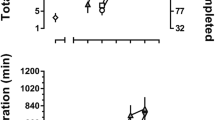Abstract
Self-injection of phencyclidine HCl (PCP) and four of its analogues was examined in baboons. IV injections of drug were dependent upon completion of 160 lever presses (a 160-response fixed-ratio schedule). A 3-h time-out period followed each injection, permitting a maximum of eight injections per day. Self-injection performance was first established with cocaine and, once stable, test doses of each drug were substituted for 15 days. All five compounds maintained maximal self-injection performance, differing only in their relative potencies. The order of potency was approximately PCP>NMPCA=TCPY>NNBPCA>ketamine. Analysis of the distribution of injections throughout the day indicate that lower doses (and vehicle) were injected mainly during the daylight hours (i.e., 9 AM–6 PM), but as the dose was increased the injections became more uniformly distributed. Only the highest doses of these compounds affected food intake, though the degree of suppression was modest. No differences between these compounds with respect to their abuse potential could be found.
Similar content being viewed by others
References
Bailey K, Chow YK, Downie RH, Pike RK (1976) 1-Piperidinocyclohexanecarbonitrile, a toxic precursor of phencyclidine. J Pharm Pharmacol 28:713–714
Balster RL, Johanson CE, Harris RT, Schuster CR (1973) Phencyclidine self-administration in the rhesus monkey. Pharmacol Biochem Behav 1:167–172
Balster R. L., Woolverton W. L. (1980) Continuous-access phencyclidine self-administration by rhesus monkeys leading to physical dependence. Psychopharmacology 70:5–10
Carroll ME, France CP, Meisch RA (1981) Intravenous self-administration of etonitazene, cocaine and phencyclidine in rats during food deprivation and satiation. J Pharmacol Exp Ther 217:241–247
Carroll ME, Meisch RA (1980) Oral phencyclidine (PCP) self-administration in rhesus monkeys: Effects of feeding conditions. J Pharmacol Exp Ther 214:339–346
Cone EJ, Darwin WD, Yousefnejad D, Buchwald WF (1979) Separation and identification of phencyclidine precursors, metabolites and analogs by gas and thin-layer chromatography and chemical ionization-mass spectrometry. J Chromatogr 177: 149–153
Findley JD, Robinson WW, Gilliam W (1971) A restraint system for chronic study of the baboon. J Exp Anal Behav 15:69–71
Findley JD, Robinson WW, Peregrino L (1972) Addiction to secobarbital and chlordiazepoxide in the rhesus monkey by means of a self-infusion preference procedure. Psychopharmacologia 26:93–114
Finney DJ (1964) Statistical method in biological assay. Hafner, New York
Griffiths RR, Bigelow GE, Henningfield JE (1980a) Similarities in animal and human drug-taking behavior. In: Mello NK (ed) Advances in substance abuse: Behavioral and biological research. JAI, Greenwich, CN, pp 1–90
Griffiths RR, Bigelow GE, Liebson I, Kaliszak JE (1980b) Drug preference in humans: Double-blind choice comparison of pentobarbital, diazepam, and placebo. J Pharmacol Exp Ther 215:649–661
Griffiths RR, Bigelow GE, Liebson I (1979a) Human drug self-administration: Double-blind comparison of pentobarbital, diazepam, chlorpromazine and placebo. J Pharmacol Exp Ther 210:301–310
Griffiths RR, Brady JV, Bradford LD (1979b) Predicting the abuse liability of drugs with animal drug self-administration procedures: Psychomotor stimulants and hallucinogens. In: Thompson T, Dews PB (eds) Advances in behavioral pharmacology, vol 2. Academic, New York, pp 163–208
Griffiths RR, Lukas SE, Bradford LD, Brady JV, Snell JD (1981) Self-injection of barbiturates and benzodiazepines in baboons. Psychopharmacology 75:101–109
Griffiths RR, Winger G, Brady JV, Snell JD (1976) Comparison of behavior maintained by infusions of eight phenylethylamines in baboons. Psychopharmacology 50:251–258
Griffiths RR, Wurster RM, Brady JV (1975) Discrete-trial choice procedure: Effects of naloxone and methadone on choice between food and heroin. Pharmacol Rev 27:357–365
Hampton RY, Medzihradsky F, Woods JH, Dahlstrom PJ (1982) Stereospecific binding of 3H-phencyclidine in brain membranes. Life Sci 30:2147–2154
Jasinski DR, Cone EJ, Gorodetzky CW, Risner ME, Shannon HE, Su TP, Vaupel DB (1979) Progress report from the NIDA Addiction Research Center. Nat Inst Drug Abuse Res Monogr 27:61–69
Jasinski DR, Shannon HE, Cone EJ, Vaupel DB, Risner ME, McQuinn RL, Su, TP, Pickworth WB (1981) Interdisciplinary studies on phencyclidine. In: Domino EF (ed) PCP: Historical and current perspectives. NNP Books, Ann Arbor MI, pp 331–400
Johanson CE, Balster RL (1978) A summary of the results of self-administration studies using substitution procedures in primates. Bull Narc 30:43–54
Kalir A, Edery H, Pelah Z, Balderman D, Porath G (1969) 1-Phenylcycloalkylamine derivatives. II. Synthesis and pharmacological activity. J Med Chem 12:473–477
Kalir A, Maayani S, Rehavi M, Elkavets R, Pri-Bar I, Buchman, O, Sokolovsky, M. (1978) Structure-activity relationship of some phencyclidine derivatives: In vivo studies in mice. Eur J Med Chem 13:17–24
Lukas SE (1983) Subcutaneous splicing of intravenous and intragastric catheters. Pharmacol Biochem Behav 18:267–268
Lukas SE, Griffiths RR, Bradford LD, Brady JV, Daley L, Delorenzo R, (1982) A tethering system for intravenous and intragastric drug administration in the baboon. Pharmacol Biochem Behav 17:823–829
McCarthy DA, Harrigan SE (1977) Dependence-producing capacity of ketamine in the Macaca mulatta. In: Hulsz E, Sanchez-Hernandez JA, Vasconcelos G, Lunn JN (eds) Anaesthesiology: Proceedings of the Sixth World Congress of Anaesthesiology. Excerpta Medica, Amsterdam, pp 160–168
Moreton JE, Meisch RA, Stark L, Thompson T (1977) Ketamine self-administration by the rhesus monkey. J Pharmacol Exp Ther 203:303–309
Pickens R, Thompson T, Muchow, DC (1973) Cannabis and phencyclidine self-administration by animals. In: Goldberg L, Hoffmeister F, (eds) Psychic dependence: Bayer-Symposium IV. Springer, Berlin Heidelberg New York, pp 78–86
Risner ME (1982) Intravenous self-administration of phencyclidine and related compounds in the dog. J Pharmacol Exp Ther 221:637–644
Shannon HE (1981) Evaluation of phencyclidine analogs on the basis of their discriminative stimulus properties in the rat. J Pharmacol Exp Ther 216:543–551
Shulgin AT, MacLean DE (1976) Illicit Synthesis of phencyclidine (PCP) and several of its analogs. Clin Toxicol 9:553–560
Smialek JE, Monforte JR, Gault R, Spitz WU (1979) Cyclohexamine (rocket fuel): Phencyclidine's potent analog. J Anal Toxicol 3:209–212
Vincent JP, Kortalovski B, Geneste P, Kaminka JM, Lazdunski M (1979) Interaction of phencyclidine (angel dust) with a specific receptor in rat brain membranes. Proc Natl Acad Sci USA 76:4678–4682
Author information
Authors and Affiliations
Rights and permissions
About this article
Cite this article
Lukas, S.E., Griffiths, R.R., Brady, J.V. et al. Phencyclidine-analogue self-injection by the baboon. Psychopharmacology 83, 316–320 (1984). https://doi.org/10.1007/BF00428537
Received:
Accepted:
Issue Date:
DOI: https://doi.org/10.1007/BF00428537




